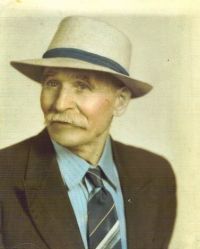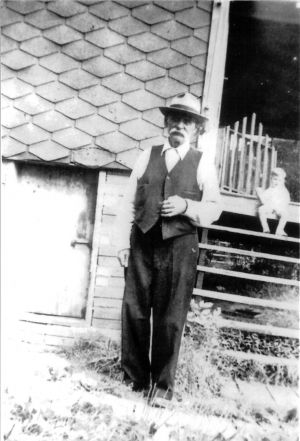Stephen Timko Sr
Stephen Timko Sr - He was the patriarch of the Timko family in America. He immigrated to this country in 1895 to work in the coal mines of western Pennsylvania. He would work in this country for 12 years before his wife Maria and sons Joseph, Andrew and John would finally join him. coal mines. There is evidence that supports the fact that Stephen traveled back and forth a number of times to his homeland during this period.
Description
Stephen, or Stif to his friends, was a stocky individual who stood about 5 foot 6 inches in height. His had dark brown hair, brown eyes and wore a broad mustache for most of his life. Also, he was almost always seen wearing a broad-brimmed hat.
Early Years
My great grandfather Steven, was born on August 22, 1869 in the small village of Kurucszfalva, in the county of Zemplin in eastern Slovakia, which was in the northern portion of Austro-Hungarian Empire at the end of World War I. His birth name was Istvan Timko Czanovzky as documented on his immigration papers. His first name was later be Americanized to Stephen.
It should be noted that at that time of his birth there were no actual birth certificates created. And most certainly no paperwork was created for the “mere” peasants of an occupied country. It therefore fell to the church to provide the only actual “paperwork” that made Stephen the newest member of their congregation. His arrival was nothing more than an entry into a ledger maintained by the local church containing, in part, the congregation’s baptismal records.
One must remember that in those times the clergy was responsible for maintaining the ledgers in regards to the major events of their parishioners, i.e. baptism, marriage and death. The entries were typically written by hand, in script, and were in Latin, the language of the Catholic Church. However, it was not uncommon to find some of the entries written in Hungarian, Magyar or Slovak. These language barriers make reading these ledgers extremely difficult and tedious to read. Also, adding to the confusion is that the ink has often times faded from the passing of time or the pages suffered from physical damage, such as water damage.
Because the region in which Joseph was born had been conquered numerous times in its history, cities and counties might be referred to by as many as eight different names depending the occupier at the time. It also should be noted that any reference to the existence of an actual baptismal certificate for Joseph must be viewed as only a partial truth. As I have pointed out, actual paper certificates were simply not created in that period for the working class. However, in today’s world, certificates can be obtained by contacting the proper authorities in the region. These documents are no more than a transcribed record created from the information contained in the church’s original ledgers. This is similar to requesting a copy of your birth certificate nowadays to submit as a means to verify one’s employment eligibility.
Emigration & Immigration
Documentation shows that in 1895, Joseph’s father Stephen Timko Sr. immigrated to America, taking the first step towards bringing his family to their new home. However, given that Stephen’s sons Andrew, who was born in 1900, and John, who was born in 1905, both were born in Slovakia and that they did not immigrate until 1907, gives credence to the concept that Stephen must have returned to his former home on a subsequent visit(s).
Naturalization
Paperwork:
On July 7, 1921, Joseph became a naturalized citizen of the United States of America.
Csanovsky:
On Joseph’s naturalization documents, which were filed in Indiana, Pennsylvania, it stated that his wife Mary and her three sons Joseph, Andrew and John entered this country under the surname of Csanovsky. Documents from Ellis Island support this revelation but neither set of documents offer any explanation for the use of a second surname. One reason offered by relatives for the use of the surname Csanovsky was the existence of an immigration quota system that would have excluded them had they tried to enter the United States under the name of Timko. However, I have a problem with this explanation. It would imply that the family stated their surname and discovered that the country was too full of Timkos. And if that was the case, upon learning this valuable bit of information, did they simply tell the customs official, “I made a mistake. My real surname is Csanovsky.” There has to be more to the story.
And there is one additional point that should be included with this discussion of surnames. That Stephen's surname was recorded on his son Joseph’s birth certificate from Slovakia as Istvan Timko Csanovsky. The name Csanovsky was therefore existed for fourteen years prior to his son Joseph’s immigration. Whether the original surname of the family was Csanovsky or Timko, we may never know. All we know for certain was the surname Csanovsky was used to enter the United States and for some reason abandoned in favor of the surname Timko. While both the Csanovsky & Timko names were recorded on early documentation, only the surname Timko survived.
Education
There is no known record of whether or not Stephen attended school however U.S. Federal Census documents indicate he could read and write.
Family Years
Married Maria Kenderis in or about 1895 in Hungary. The couple had eleven children: six boys - Stephen Jr, Joseph John, Andrew George, John Joseph, Paul John and Michael Joseph, and one girl - Anna Margaret.
The couple would have eventually have seven children;
- Stephen Timko Jr
- Joseph John Timko Sr
- Andrew George Timko
- John Joseph Timko
- Paul John Timko
- Michael Joseph Timko
- Anna Margaret Timko
Residences
During the family's years in Indiana County, Pennsylvania Stephen and Mary lived in an unknown number of company houses but eventually purchased a house of their own.
Working Years
Worked as a coal loader at the various coal mines that dotted the Indiana County, Pennsylvania countryside.
Personal Life
Joseph enjoyed puttering around in his vegetable garden, reading the newspaper, and searching for mushrooms in the surrounding countryside. He also enjoyed spending time with his family.
Death
Stephen died from cardiac failure as the result of carcinoma of the pancreas on March 21, 1949 at his home in Dixonville, Indiana County, Pennsylvania.
He was buried on March 24, 1949 at St Bernard's Cemetery in Indiana, Indiana County, Pennsylvania.

